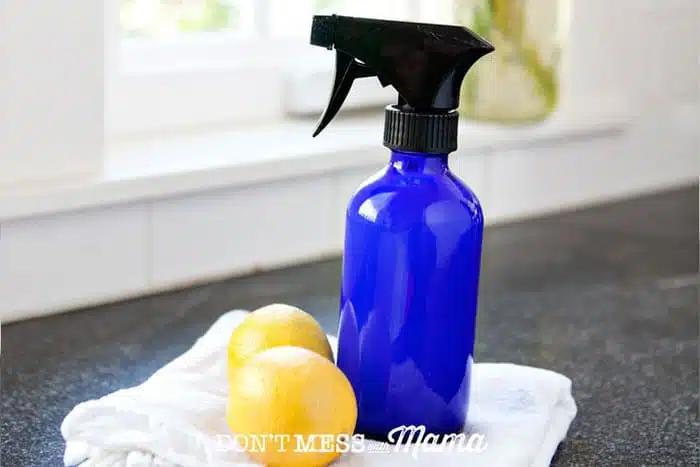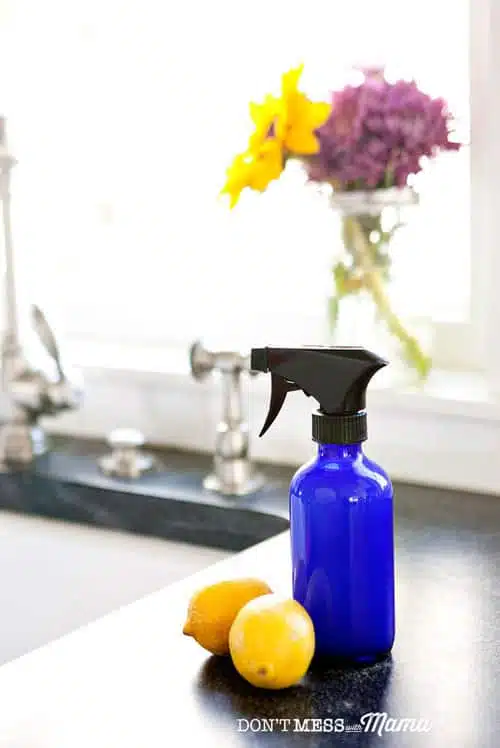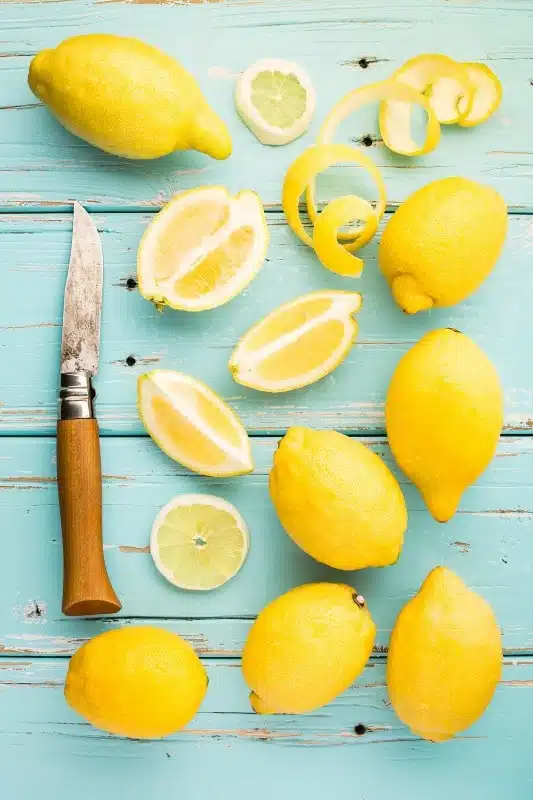DIY Natural Disinfectant Spray (Homemade Lysol) + Top 4 Natural Disinfectants
Ditch the Lysol and antibacterial sprays for good with this DIY Natural Disinfectant Spray. It’s so easy to make and will sanitize without the harsh chemicals.
This post contains affiliate links. Please read my affiliate disclosure.

It never fails. With three boys in the house, there’s a constant influx of germs in the house from my kids playing outside and in a creek near our house. They’re always coming home with critters too like geckos, turtles (seriously), crawfish and even birds. I usually shoo them back outside with said critters but not before they get their hands on doorknobs, walls, tables, and other surfaces in my home.
And no matter how many times I tell them to wash their hands… well, sometimes germs just happen. That’s why I’m so happy to have a natural alternative to Lysol and other antibacterial sprays for my home.
The funny thing is that I was THAT mom who had the bleach wipes and cleaned every surface of the house with them. I remember one time I was on my hands and knees cleaning the floor to keep them “clean” for my son (who was a crawling baby back then). I just cringe thinking about it now. I probably exposed him to chemical toxins that were far more harmful to his health than if I just used soap and water to clean the floors.
My kids have definitely been the turning point for me in transitioning to a chemical-free lifestyle. We’ve already gotten rid of all of our household cleaners and now basically use this one for everything.
But here’s the thing… germs still happen and sometimes you just want to disinfect. So what can you use if it’s not Lysol or bleach?
It’s actually pretty easy – it’s just all those TV commercials have us all thinking we need bleach wipes or some toxic spray can to disinfect and get rid of germs when really we CAN use natural alternatives.
How To Make This Natural Disinfectant – Step by Step
-
In a 16 oz spray bottle, add peels of 2-3 lemons.
-
Fill jar with with 1.5 cups of vodka (120 proof or higher).
-
Ideally, let lemon peels sit it the vodka for 1-2 weeks to get the lemon oil from the peels. If you don’t have the time, you can start using right away.
-
Shake well and put the spray nozzle on.
-
To use, spray on surfaces and let sit for a minute to disinfect. Then wipe up with a paper towel.
Note: You can use 70% isopropyl alcohol instead of the vodka. Just be aware of the surfaces you use them on (read more about the top 4 disinfectants below). You can use isopropyl alcohol with a higher alcohol content like 91% and juts add a bit of water to dilute it to 70% if you like. More on that below.
CDC Recommendation
The CDC recommends at least 70% alcohol to disinfect surfaces. The alcohol can be either ethanol (like the alcohol you drink) or isopropyl alcohol (like rubbing alcohol).
Now you’ll notice that with drinking alcohol, the alcohol content is noted on the bottles as “proof”. Divide the proof by half to figure out the percentage of alcohol in the bottle. So you’ll want to get drinking alcohol of at least 140 proof for 70% alcohol content. Make sense? Vodka can range from 80 proof to 191 proof. Everclear comes in 120, 151, 189, and 190 proof – ranging from 60-95% alcohol content.
Keep in mind that you can dilute with water to get at least 70% alcohol content. So if you have Everclear at 190 proof (which 95% alcohol), you can use 3 parts of Everclear with 1 part of water content to make a CDC-recommended disinfectant at 70% or more.
If you prefer to use isopropyl alcohol, just be mindful of the ratio. You can do 4 parts of 91% isopropyl alcohol and 1 part water, you would have a homemade disinfectant spray with 72% alcohol (91 x 4/5).
Top 4 Natural Disinfectants
There are a handful of products you can use to naturally disinfect and sanitize your home. You probably already have them in your home. They are all effective in killing germs and sanitizing surfaces and toys. Again, remember if you are following CDC recommendation stick with isopropyl (rubbing) alcohol or ethanol (drinking alcohol like vodka) at 70% or higher alcohol content.
Let’s go over each one and I’ll explain the best places to use them:
1. Hydrogen Peroxide
Hydrogen Peroxide at 3% or higher an be used on most surfaces to disinfect. You can just put a spray nozzle on the bottle to disinfect surfaces like doorknobs, toilet seats, etc. Opt for food-grade hydrogen peroxide to disinfect surfaces that touch food like cutting boards or the lids of canned food you buy from the store.
Avoid using on carpets, upholstery, curtains, and fabrics (unless you want to whiten) as it is a natural bleach and will whiten. But you can use in the laundry if you’re looking to whiten naturally. Check out my DIY Bleach Alternative.
How to use to disinfect: Spray a cloth and wipe down surfaces like computer keyboards, cellphones, doorknobs, toilet seats, etc. to naturally disinfect. Use direct from the bottle or 1:1 dilution with water in a spray bottle. Clean toys by filling a tub half full with water and add about 1-2 cups of. Soak toys for about 30 minutes and then drain and allow to air dry. For laundry, add 1 cup to white clothes or towels and wash as usual in the washing machine with your favorite laundry detergent.
2. Rubbing Alcohol
Rubbing Alcohol (or isopropyl alcohol at 70% alcohol content or higher) is a powerful disinfectant but has a strong scent that requires a well ventilated area and open windows. Use it to clean toilets and tubs. Never clean with rubbing alcohol and bleach together. It creates a toxic mixture that can cause serious health issues. It can be used to clean fabrics and carpets to remove stains, but be sure to pre-check fabrics first.
Avoid using on furniture with finishes (like lacquered or varnished surfaces) as it will remove the finish. It is highly flammable so take caution.
How to use to disinfect: Spray direct or wipe on with a cloth on surfaces or dilute as needed in a spray bottle – either 1:1 or 1:2 with water.
3. Vinegar
Vinegar is one of my all-time favorite disinfectants. It can be used on many surfaces to clean and sanitize, including food surfaces, kitchens, floors, windows, tubs, tile, laundry and so much more. It’s my preferred method of cleaning produce like fruit and vegetables. Check out this DIY Produce Wash recipe. Now do keep in mind that it can kill some bacteria and viruses, but not all.
The downside with vinegar is the smell. Add lemon juice or essential oils to help with the scent. Vinegar is great in laundry and actually doesn’t leave a scent on fabrics when they’re washed. Check these 13 Surprising Ways to Use Vinegar.
Avoid using vinegar on granite, marble, stone floors or surfaces, hardwood floors, and iron. The acid in the vinegar can breakdown the natural stone, wood and iron.
How to use to disinfect: Spray direct or wipe on with a cloth on surfaces or dilute 1:1 in a spray bottle. For laundry, add 1 cup vinegar to washing machine and wash with clothes.
4. Vodka
Vodka (at 140 proof or higher) is a fantastic natural disinfectant on food surfaces like cutting boards and on fabrics like upholstery and curtains. Vodka naturally deodorizes fabrics and carpets, so it’s the cleaner of choice as a DIY Fabric Refresher without the harsh chemicals. It is flammable so take caution when using but it’s great as an all-around disinfectant.
How to use to disinfect: Put a spray nozzle on the bottle and spray direct on surfaces or dilute 1:1 in a spray bottle.
Make a Natural Disinfectant as Effective as Bleach
It is possible to make a natural disinfectant as effective as bleach. All you need is hydrogen peroxide and vinegar. Now it’s important NOT to use the two together at the same time. Rather, use them separately to make a disinfectant that’s better than bleach.
- Clean surface with vinegar. Use a cloth or paper towel to wipe the area clean.
- Spray the surface with a 3% hydrogen peroxide (straight, not diluted) and let air dry.
This works really well for surfaces like doorknobs, tubs, tile, toilets, etc. You could even do this with cutting boards and use a food-grade hydrogen peroxide instead or if you’re comfortable using regular hydrogen peroxide you can do that.
Typically, for cutting boards or food prep I opt for vodka instead since it’s more readily available. That’s why I love this DIY Disinfectant Spray.

About the Ingredients – Making A Natural Disinfectant Spray
Lemon peels
Lemon peels have antibacterial properties due to the essential oils in the rinds. It’s like when you squeeze a lemon you’ll see the oil on the rind. That’s the lemon essential oil. The oil itself is a powerful antibacterial that has even been shown to kill Staphylococcus aureus and E. coli.
Lemon juice is a great sanitizer and kills some germs but it’s the lemon oil that’s more effective. Save the lemon juice to make my Homemade Natural Bleach.
Could you use lemon essential oil that you buy in a bottle? It depends on the source. Many essential oils are not 100% pure oils and may contain fillers or fragrance rather than actually essential oil. So unless you know the source – it’s best to use straight lemon peels or get essential oils from the source (this is what I use).
Vodka
Vodka (at 140 proof or more) is a fantastic natural disinfectant and sanitizer. While it can have a strong scent straight out of the bottle, with this DIY Disinfectant Spray recipe it will smell amazing. Plus, vodka is a natural deodorizer so you can spray fabrics and carpets too. You don’t need expensive vodka (save that for the cocktails). Get the cheap vodka and use to make this simple DIY disinfectant spray.
Removing Residue and Adhesives
Ever wasted too many minutes of your life trying to remove sticky adhesives from price tags, product labels and stickers? You can rid of the stubborn gunk by spritzing the gummy substance with this spray. Let it sit for a few minutes, then use a bit of elbow grease to scrub away the goo, plus it disinfects – a win win! Lemon essential oil works really good as a goo and gunk remover too.
A Natural Disinfectant That Sanitizes and Shines
Give all of the glass surfaces in your home (windows, mirrors, glass coffee tables) a spotless shine. Use this spray to squirt a mist of vodka and lemon onto the glass surface. Buff the glass with a bunched up newspaper and watch all fingerprint smudges and other stains disappear to a streak-free gleam and again, it sanitizes.
Top Tips For This Natural Disinfectant
- Allow your vodka lemon peel mix to sit for at least a week. But if not you can skip that step and still put fresh lemon peels in your disinfectant.
- You can use the spray as a mold remover too.
- Disinfect your mattress. This is great to do in the summertime when we tend to sweat more. Let the mattress dry completely before making the bed.

More DIY Recipes You Might Like
- DIY Natural Bleach Alternative
- Homemade Foaming Hand Soap
- Homemade Toilet Fizzies
- DIY Reusable Cleaning Wipes
Did you try this DIY Disinfectant Spray? Don’t forget to rate it and comment below to let me know how it went. You can also FOLLOW ME on Facebook, Instagram and Pinterest to see what other fun things I’m getting up to.

DIY Disinfectant Spray (Homemade Lysol)
Ingredients
- 2-3 lemons
- 1.5 cups vodka (140 proof or higher)
Instructions
- In a 16 oz spray bottle, add peels of 2-3 lemons.
- Fill jar with with 1.5 cups of vodka (140 proof or higher).
- Ideally, let lemon peels sit it the vodka for 1-2 weeks to get the lemon oil from the peels. If you don't have the time, you can start using right away.
- Shake well and put the spray nozzle on.
- To use, spray on surfaces and let sit for a minute to disinfect. Then wipe up with a paper towel.
Notes
Photo credit: Bigstockphoto.com / el lobo

Hello!! just a few questions. I have parakeets and was wondering if these recipes will hurt my birds. I won’t spray towards them at all but will clean around them. I know they are very sensitive to smells so I need to know if it will be ok to use. I have slowly getting rid of all of my toxic cleaners I hate to throw good money away. I am almost there!
Thank You
Margie
First, I’m not an expert on what’s safe for birds, but after doing some research it appears that the vinegar option might be best. I’ve read that many people use vinegar diluted with water to clean birdcages. But I recommend talking to your vet to make sure. Hope this helps.